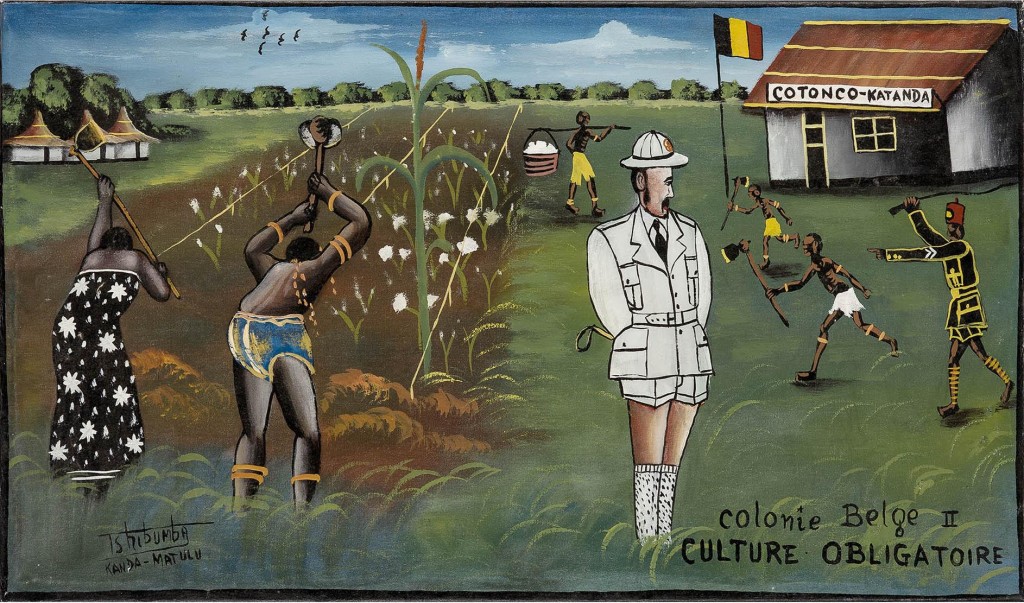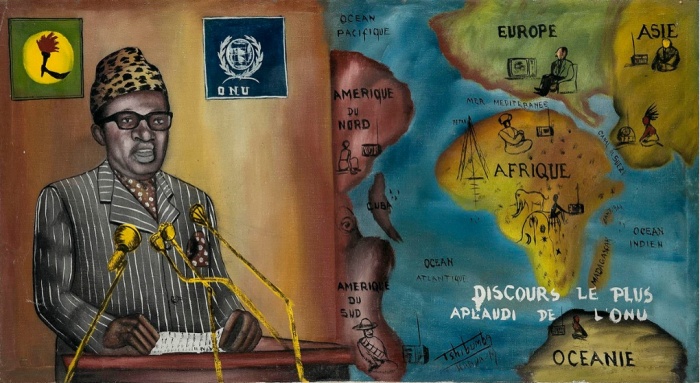
Tshibumba Kanda-Matulu is one of the artists in 53 ECHOES OF ZAIRE
Until June 30, 2015
Sulger-Buel Lovell Gallery, London
Le 30 juin 1960 Zaïre Independent
About the artist:
Tshibumba Kanda-Matulu, the lead artist in the exhibition with over 30 works, had aspirations to be a teacher but became an artist. He was already prolific when he met Etienne Bol, a Belgian man his age with whom he struck up a friendship. Between 1971 and 73, Bol commissioned Kanda-Matulu and four other artists to paint the images displayed in the exhibition.
Diop says: “Paintings (usually created on canvasses made from flour sacks) sold for very modest sums. Kanda-Matulu lived in a small one bedroom house and found it difficult to make a living from his art. He was very poor.”
 Colonie Belge.
Colonie Belge.
Despite his contribution to popular Congolese art, Kanda-Matulu’s life is shrouded in mystery. He met Etienne Bol in 1972, 10 years later, in 1982, he disappeared. People he knew thought he had gone back to his village, others speculated that he may have moved to neighboring Zambia. Given the political nature of his art, could his disappearance have been politically motivated?
Diop doesn’t think so but says: “Tshibumba was easy to find — he was always working from home. But suddenly, he wasn’t there anymore. In the troubled times (under the autocrat Mobutu Sese Seko) it was not uncommon for people to move a lot in search of a peaceful life. We don’t know if he’s alive or dead.”
About the exhibition:
 Colonie Belge.
Colonie Belge.
The Africa Centre & the Sulger-Buel Lovell gallery are pleased to announce the exhibition 53 Echoes of Zaire: Popular Painting from Lubumbashi, DRC, which will take place at the Sulger-Buel Lovell gallery, London, from May 27th.
The exhibition will be curated by Salimata Diop, Head of Programme at the Africa Centre, London. It will unveil a collection of fifty three works acquired by the late Prof. Victor Bol, all originating from the early 1970s’Lubumbashi, created by five artists from DRC: T. Kalema, C. Mutombo, B. Ilunga, Ndaie, and Tshibumba Kanda Matulu.
 Géka Mines II.
Géka Mines II.
The latter, author of over thirty of the works featured, thought of himself as a historian as well as an artist. Born in 1947 in Lubumbashi in the very south of what was then Belgian Congo, his wish was to become a teacher, but he eventually had to find another way of teaching history to his fellow countrymen. In the mid-1960s Tshibumba Kanda Matulu started training himself to paint and practiced painting as a profession from 1969. He became the main figure of an artistic movement where artists articulated a system of shared memories. Recalling ancestral origins, colonial history, the fight for independence, post-colonial struggles for power, they created artworks for local people to be bought by local people.
 Mobutu Sese Seko.
Mobutu Sese Seko.
The collection is notable for its consistency, quality and contribution to the history of Popular Painting in the urban and industrial Katanga region of the Democratic Republic of the Congo. It is accompanied by contemporary documentation and original photography featuring the principal artist in the collection, Tshibumba Kanda Matulu.
Many of the works have been included in significant international exhibitions – for instance : A Congo Chronicle: Patrice Lumumba in Urban Art, Museum for African Art, New-York, 1999-2009- or publications –such as: -60 ans de Peinture au Zaïre, Joseph-Aurélien Cornet, Remi De Cnodder, Ivan Dierickx, Wim Toebosch, Bruxelles: Les Editeurs d’Art Associés, 1989.
